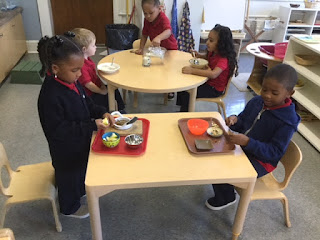One of the core curriculum areas of a Montessori classroom is called Practical Life. We begin with basic fine and gross motor skills and progress to increasingly complex activities.
 |
| Some of the earliest lessons are how to put on and take off an apron, and how to carry a tray (hands in the middle, thumbs up, flat, at belly button height!) |
 |
| Simple pouring from one container to another progresses to dividing water evenly between two containers, then using a funnel |
 |
| Variations of water transfer with baster, sponge, or dropper |
 |
| The progression for sweeping skills starts with using a small hand broom to sweep up beans on a tray |
A child may choose sweeping as an activity from the shelf (such as the tray with beans and hand broom), or they can go get a broom and dustpan if they have a spill while doing another activity. Other times, a child may notice an area that needs to be swept and choose to sweep it for the joy of sweeping and to help care for their classroom.
While sweeping is a valuable life skill in itself, we have several larger purposes for these types of activities. Physically, the children are developing coordination. Cognitively, they are learning to plan, initiate, and complete a task - executive functions that are essential skills for life. Socially and emotionally, the children build their confidence by knowing they have acquired meaningful skills and feel capable and connected when they can help take care of their classroom.
Children are also equipped and empowered to care for the classroom environment by washing tables and chairs (many-step processes that are great for building executive functions)

Cloth washing (very satisfying to scrub clean the small cloths we use for dusting!) and watering plants

All this work with water inevitably results in some spills on the floor, which provides opportunity to learn the importance of cleaning them up right away for everyone's safety. (Teaching pro-social skill of considering the needs of others)
 |
| Many young children enjoy folding classroom towels and cloths with great precision |
All these activities help children feel ownership in their classroom and encourage them to notice and take responsibility for the space.
A teacher demonstrates the full sequence of each activity to an individual or small group before the child independently engages with the work.
In addition to caring for the classroom environment, they also learn skills and activities to care for themselves. One aspect of self-care is food preparation. They have the option of serving themselves breakfast when they arrive. A few students help prepare the morning snack for the class. The children can follow portions cards to serve themselves snack whenever they are hungry and see an open space at the snack table. We also have several food preparation activities that the children can choose throughout the day.
 |
| Extracting pumpkin seeds for roasting |
 After preparing food and eating, the child washes their dishes. (Teachers also run all dishes through the dishwasher each day!)
After preparing food and eating, the child washes their dishes. (Teachers also run all dishes through the dishwasher each day!)
 |
| Hammering golf tees into a pumpkin as introductory hammering work and collaborative way to carve a pumpkin face |





 All this work with water inevitably results in some spills on the floor, which provides opportunity to learn the importance of cleaning them up right away for everyone's safety. (Teaching pro-social skill of considering the needs of others)
All this work with water inevitably results in some spills on the floor, which provides opportunity to learn the importance of cleaning them up right away for everyone's safety. (Teaching pro-social skill of considering the needs of others)

 After preparing food and eating, the child washes their dishes. (Teachers also run all dishes through the dishwasher each day!)
After preparing food and eating, the child washes their dishes. (Teachers also run all dishes through the dishwasher each day!)









No comments:
Post a Comment